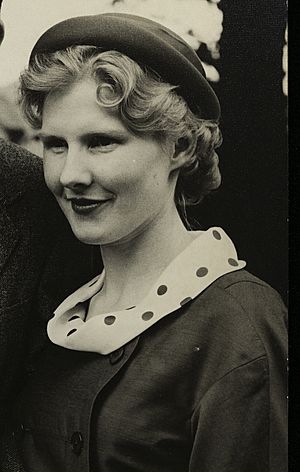Noreen Murray facts for kids
Quick facts for kids
Noreen Murray
|
|
|---|---|

Noreen Murray
|
|
| Born |
Noreen Elizabeth Parker
26 February 1935 Lancashire, England
|
| Died | 12 May 2011 (aged 76) Edinburgh, Scotland
|
| Nationality | English |
| Alma mater | |
| Spouse(s) | |
| Awards | Fellow of the Royal Society |
| Scientific career | |
| Fields | Molecular genetics |
| Institutions |
|
Lady Noreen Elizabeth Murray (born Parker; 26 February 1935 – 12 May 2011) was a brilliant scientist from England. She was a pioneer in a field called molecular genetics. This field studies genes and how they work.
Noreen Murray helped create recombinant DNA technology, also known as genetic engineering. This is a way to combine DNA from different sources. She made special tools called vectors from a virus called bacteriophage lambda. These vectors allowed scientists to insert genes into cells to study what they do.
During her career, she was known around the world as a leader in her field. She was one of Britain's most respected molecular geneticists. She worked at the University of Edinburgh as a professor of molecular genetics until she retired in 2001. She also held important positions, like president of the Genetical Society.
Contents
Early Life and Education
Noreen Parker grew up in two villages in England: Read, Lancashire and Bolton-le-Sands. She went to Lancaster Girls' Grammar School.
She studied at King's College London and earned her first degree. Later, she received her PhD from the University of Birmingham in 1959.
A Career in Science
Noreen Murray was a very dedicated researcher. She worked at several famous universities and research centers. These included Stanford University and the University of Cambridge. She also worked for the Medical Research Council (UK).
In 1967, she joined the University of Edinburgh. She briefly worked at the European Molecular Biology Laboratory from 1980 to 1982. But she soon returned to Edinburgh. In 1988, she became a professor of molecular genetics there.
At Edinburgh, she did important work on restriction enzymes. These are like tiny scissors that can cut DNA. She studied how they work and how they could be used as tools in modern biology. She often published her research by herself. This shows she was the main person behind many discoveries.
In 1968, Noreen became interested in how bacteria "restrict" or block foreign DNA. She used a virus called bacteriophage lambda to study this in bacteria called Escherichia coli.
Working with Kenneth Murray
Noreen was married to Sir Kenneth Murray. He was also a famous biochemist. Together, they helped create a vaccine for hepatitis B. This was the first vaccine made using genetic engineering that was approved for humans.
Noreen, Ken, and their colleague Bill Brammar helped lead the development of genetic engineering. Their work put the UK at the forefront of DNA research. They were among the first to understand that restriction enzymes could cut DNA. This meant different DNA pieces could be joined together. This process creates recombinant DNA molecules and allows scientists to clone DNA sequences.
Their discoveries had a huge impact on all areas of biology and biotechnology. In their shared research, Noreen's contributions were clear. She was the expert in genetics, and Ken was the expert in biochemistry.
Supporting Other Scientists
Noreen Murray was a great role model for other women scientists. It was not always easy for women to have a science career in her time. But she reached the top of her profession. She was very supportive of her female colleagues. She was happy when they succeeded. She was also an excellent mentor to those who worked with her.
In 1983, Noreen and Kenneth started the Darwin Trust of Edinburgh. They donated the money they earned from the Hepatitis B vaccine to this charity. The trust supports education and research in natural science. It has helped build the Darwin Library at the University of Edinburgh. It has also provided money for students from other countries to study in Edinburgh.
Legacy and Recognition
Noreen Murray's many contributions to science were recognized with many honors. She was elected a Fellow of the Royal Society in 1982. She also became a Fellow of the Royal Society of Edinburgh in 1989.
She received special degrees from several universities. These included the University of Warwick and Lancaster University. She also received the Gabor Medal of the Royal Society in 1989 for her work with lambda phage.
In 2002, she was made a Commander of the Order of the British Empire (CBE). This is a high honor in the UK.
The Noreen and Kenneth Murray Library at the University of Edinburgh's King's Buildings campus is named after them. This honors their important careers and their dedication to science and engineering.
Later Life and Death
In 2010, Noreen Murray was diagnosed with a type of motor neurone disease. This disease affects how the brain controls muscles. In 2011, even though she could not speak, she continued to work. She communicated by writing notes. She passed away on 12 May 2011, at the age of 76. Her husband Ken was with her.
See also
 In Spanish: Noreen Murray para niños
In Spanish: Noreen Murray para niños

